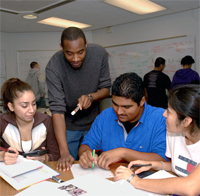Teaching a Previously Designed Course for the First Time

Synopsis:
Derek Johnson is starting his first faculty position after graduation and has been assigned to teach thermodynamics. Though he received pre-existing course materials, he would like to adapt the materials to his own goals and style. His department chair offered him a number of suggestions to help him take ownership of the class.
Derek Johnson is starting his first faculty position after graduation and has been assigned to teach thermodynamics. Though he received pre-existing course materials, he would like to adapt the materials to his own goals and style. His department chair offered him a number of suggestions to help him take ownership of the class.
Full Story:
Dr. Johnson has recently been hired by the Chemical Engineering department to teach thermodynamics. This is the first class he will teach as a faculty member and he didnít get much teaching experience as a PhD student.
Dr. Johnson has recently been hired by the Chemical Engineering department to teach thermodynamics. This is the first class he will teach as a faculty member and he didnít get much teaching experience as a PhD student.
Strategies Menu
He was given a set of course materials that included last year's course syllabus, textbook, homework problems, and copies of lecture notes. While he realizes that getting so much information could be beneficial, it is also causing him problems.
In reviewing these materials, he has realized that they are out-of-date. Derek wants the class to use current thermodynamic problems to apply fundamental principles, and he is considering weaving in examples from his dissertation work.
Derek understands that he also needs to meet his departmentís expectations for course content. Plus, he wants to feel comfortable that he has something to offer the students.
Due to his minimal teaching experience, he has not adapted pre-existing materials for his own use before, so he spoke with his department chair. His chair helped him understand how the thermodynamics class fits into the chemical engineering curriculum and then offered additional suggestions:
- Take time to understand the courseís learning objectives. Learning objectives describe the expected knowledge and skills your students will achieve from your course. Reflect on how the objectives meet the departmentís expectations and how they align to the ABET program outcomes, and then refine them as necessary to meet your goals.
- To take ownership of the class while using existing course materials, understand the rationale that underlies the decisions of the original course design, and then make changes strategically. Review the material to ensure each piece fosters the learning objectives. Or talk to the professor who last taught this class to understand why she included certain materials, why she chose the textbook, or why the topics are covered in a particular sequence. Then make the fewest number of changes, keeping whatever existing material is still appropriate.
- You may need to limit your course prep so that your research work is not sacrificed. You should balance course preparation with other faculty activities.
- Teaching is an art and skill that is refined over many years, so continually seek out useful teaching advice from more experienced teachers.
Dr. Johnson allotted some time to understand the course, then updated a few materials and left some changes for future terms. This effort helped Derek feel more confident that he had expertise to offer the students.
